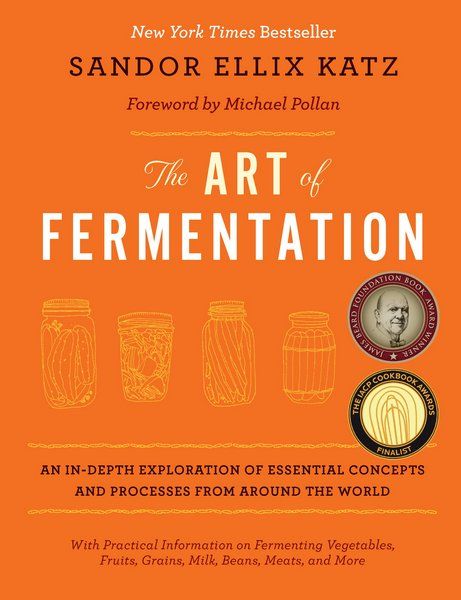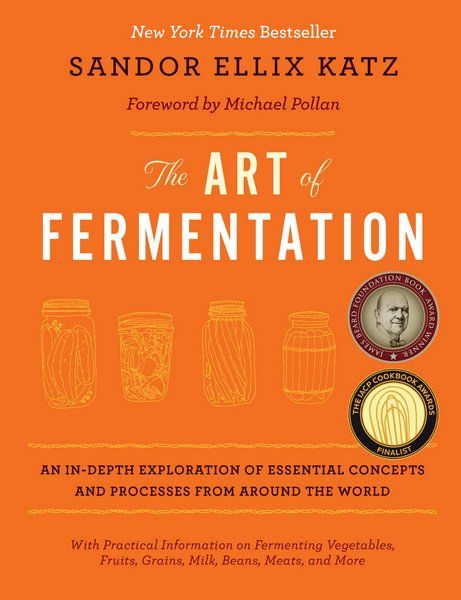Description
An In-Depth Guide to the Art of Fermentation
Book By Sandor Ellix Katz, with foreword by Michael Pollan
What "The Art of Fermentation" is about
This has to be one of the most accurate book titles ever. Author Sandor Ellix Katz writes exactly about what he announces in the title, and then some! This is, hands down, the most comprehensive, in-depth book ever written on fermentation. The Art of Fermentation, which is essentially a cookbook, was a New York Times bestseller! In addition to this prestigious accolade, it also won the 2013 James Beard Foundation Book Award. The reason for this is not only the depth of analysis the author goes into – it is also his writing style. Even if you’ve never even heard about lactic-acid fermentation, the seductive narrative style will have you glued to the book until you've read it cover to cover. It will thrill and excite readers about the many methods of healthy food preservation, and get you hungry to start experimenting with some of these wonderful recipes yourself!
The Contents
The term "i n-depth exploration" is an understatement. This Book covers just about every known way people have preserved their food throughout history and across the globe. The author explores everything you’d ever want to know about natural food preservation. Not only that, he writes about it with the enthusiasm of a naval explorer navigating an expedition through uncharted territories.The author of this incredible fermentation guide stresses the importance of fermentation in the very first chapter. He even calls fermentation a " co-evolutionary force ." In this chapter he goes into great detail about the history of mankind and the importance this method of food preservation played for human health and survival.
The following chapter goes into more detail about the health benefits of the fermentation process, but it also goes to great lengths to highlight the extraordinary flavors fermented foods offer.
After that, you will learn all about the necessary equipment, as well as the basic practical concepts of food preservation. Here, you will find out all about fermentation vessels: jars, crocks , metal, plastic and wooden vessels. This section also covers cutting and shredding techniques for different ferments. It goes into great detail about cabbage shredders , slicers and also various pounding devices, including cabbage stompers .
Other features of the book describe in remarkable detail the following fermented products:
- Fermenting Sugars into Alcohol: Meads, Wines and Ciders
- Fermenting Vegetables and Fruits (check out another great book on canning and fermenting vegetables and fruits )
- Sour Tonic Beverages (kvass, root beers, kombucha, homemade vinegar and many others)
- Fermented Milk Products (yogurt, kefir, whey, cheese…)
- Grains and Starchy Tubers
- Fermenting Beers and Other Grain-Based Alcoholic Beverages (saké, rice beer, barley beer and a whole galaxy of other beers)
- Mold Cultures
- Fermenting Beans, Seeds and Nuts
- Meat, Fish and Eggs
A huge number and variety of fermentation recipes
This is where this book goes above and beyond the call of duty of your average fermentation guide. Most guides cover basic dishes made from shredded vegetables, such as sauerkraut, coleslaw, kimchi , etc. This book details just about every imaginable food that can be preserved this way, including fruits, meat, eggs, fish, beans, seeds, nuts and many more. It even gives you a guide how to make your own homemade fermented alcoholic beverages, such as wines, ciders and beers!Comprehensive and Exhaustive
The amount of information covered is just incredible. At around 500 pages, the book details just about every imaginable aspect of homemade food preservation. It even gives tips to those considering starting commercial enterprises dealing with fermented foods. Finally, the author gives a very useful and extensive glossary of terms used in this field, as well as a comprehensive list of resources and references.
Get Started!
When it comes to fermentation guides, this is by far the most detailed and in-depth book you will find on the market. Not only is it informative, it is written in such an exciting way that you will want to cut, shred and ferment your first batch before you complete the first chapter. The author has such a wonderful style that it comes as no surprise that " The Art of Fermentation, " which is essentially a recipe book, was a New York Times bestseller! And considering its volume and the amount of priceless information you get for the cost, this book is a bargain you simply cannot afford to miss.

